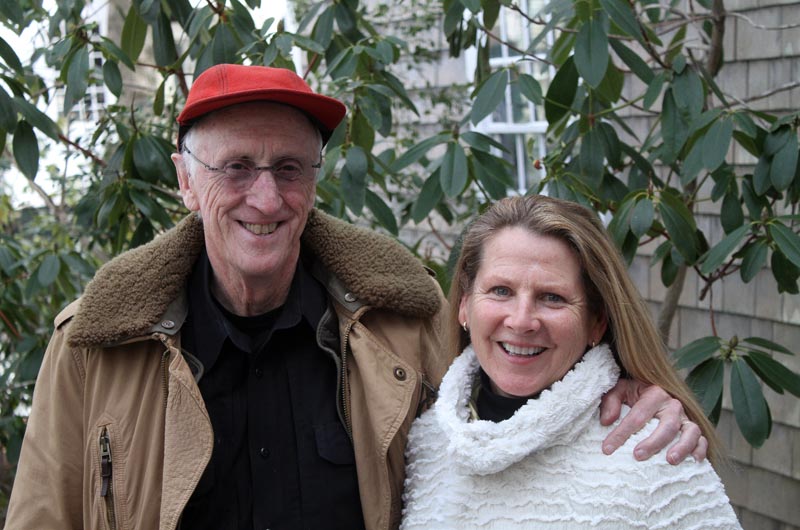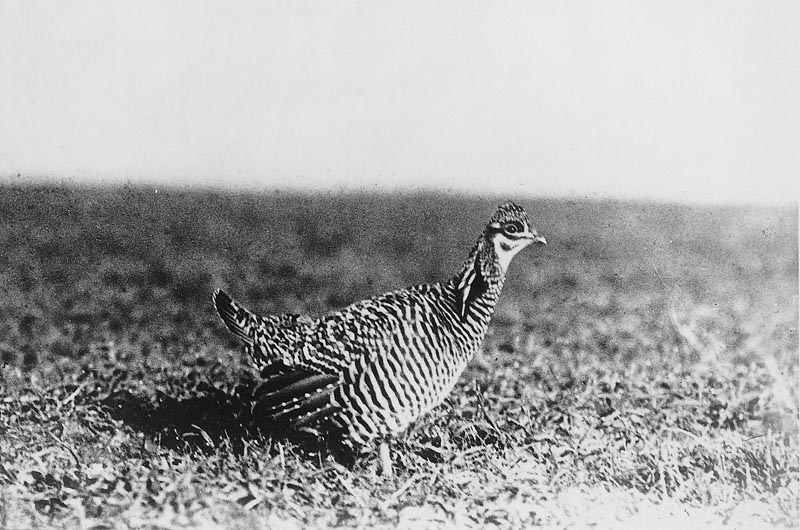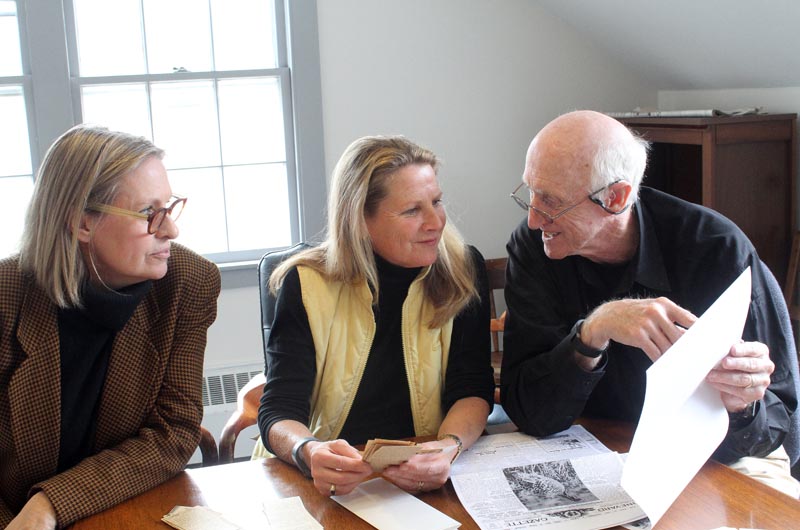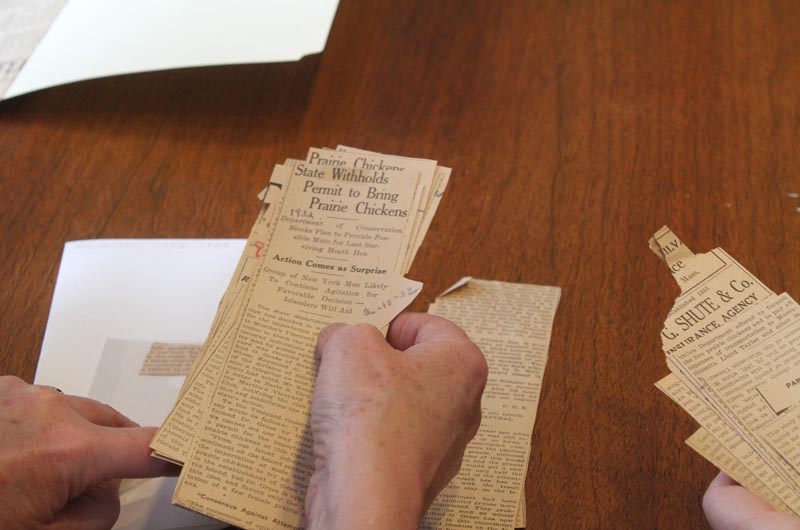The last heath hen died on Martha’s Vineyard in 1932. Despite an Islandwide effort to save the last living member of this species, a 10-year-old male nicknamed Booming Ben, the Vineyard became the reluctant host of an extinction.
“There is no survivor, there is no future, there is no life to be recreated in this form again,” Vineyard Gazette editor Henry Beetle Hough wrote in a 1933 editorial.
But in the 80 years since, scientific advances Mr. Hough could not have foreseen have blurred the finality of extinction. Martha’s Vineyard could now be the site of a resurrection. The heath hen is currently being proposed as a possibility for de-extinction by Revive & Restore, an organization that aims to coordinate projects that use genetics to rescue endangered and extinct species.
“In a way it’s picking up a story we thought was over,” Revive & Restore co-founder Stewart Brand said during an interview at the Gazette offices last week. “Martha’s Vineyard worked really, really hard to save this bird, and what if the fight isn’t over? The bird isn’t gone, it’s just sleeping.”

“Waking it up is going to take a lot of coherent effort and a certain amount of money and the rest of it,” he continued. “But it’s not as gone as it would be if the DNA were gone. It’s not gone like dinosaurs are gone.”
Mr. Brand and Revive & Restore executive director Ryan Phelan were on the Island last weekend to meet with Island leaders and members of the conservation community to discuss a potential heath hen revival project and gauge local interest.
The heath hen de-extinction effort, Ms. Phelan and Mr. Brand emphasize, is in the early stages and the conversation is just beginning. Even if the science is there — and they say it is — the project would require community support and it would unfold over decades. The revival would touch on issues and questions that are scientific, ecological, political, cultural, economic and historical.
Revive & Restore is also working on the de-extinction of the passenger pigeon (extinct in 1914) and possibly the woolly mammoth (extinct about 4,000 years ago), among other animals. Bringing back the heath hen, they said, could make the Vineyard a trailblazer while reviving a much-mourned bird.
“It’s one of those things that is really just a big idea,” Ms. Phelan said. “And we came to Martha’s Vineyard with the idea and we’re just sort of throwing it out there and whispering it around and seeing if anybody jumps at it.”
“The life-listers of birds would have a field day,” Mr. Brand said. “Wouldn’t that make the Christmas Bird Count fun?”
Revive & Restore is a non-profit project within The Long Now Foundation. It was co-founded by Ms. Phelan and Mr. Brand. Ms. Phelan, the executive director, has a background in genetics, including founding DNA Direct, and was the co-founder of the ALL Species Foundation. Mr. Brand, an author and ecologist, created and edited the Whole Earth Catalog. The couple is married and live in northern California.
Mr. Brand and Ms. Phelan are joined in the heath hen effort by Susan Johnson Banta, who met Ms. Phelan and Mr. Brand at a party near San Francisco last summer. “I had no idea this was going on in the world, that people were working on de-extinction, and it sounded a little bit out there to me, to be honest,” she said.
“When they mentioned the heath hen and Martha’s Vineyard my ears perked up.”
Ms. Johnson Banta has been visiting the Vineyard for at least 40 years and she offered to feel out Vineyard sentiment on the project. “It started this conversation which has just mushroomed along with my interest, and has brought us here today,” she said. Ms. Johnson Banta serves as a community development consultant for the heath hen project. She said the Vineyard response has been overwhelmingly positive.
Oak Bluffs seasonal residents Peter and Gwen Norton are major donors to Revive & Restore. They hosted Mr. Brand and Ms. Phelan last weekend.
The heath hen, Tympanuchus Cupido Cupido, was once abundant on the East Coast. Hunting severely diminished the population, and in the 1800s heath hens mostly disappeared from the mainland, coming to exist only on Martha’s Vineyard. The Vineyard population went up and then down, aided in decline by man, fire and cats, according to the Gazette archives. There were efforts to save the species, including a discussion about bringing in greater prairie chickens to mate with the heath hens, an idea that was never brought to fruition. Acres of land in the middle of the Island were preserved for the heath hen, which eventually became the Manuel F. Correllus State Forest. Despite this, the population dwindled to unsustainable numbers.
In the 1920s and 1930s, the heath hen “may have been starting into what they call the extinction vortex,” Mr. Brand said, which is the genetic bottlenecking that occurs when inbreeding is increasingly an issue from generation to generation.
By 1928, there was a lone survivor, Booming Ben. He was last seen in March 1932. A Gazette article from April 1933 reported that the species was officially declared extinct with the death of Booming Ben. “Place and manner of death unknown.”
“Somewhere on the great plain of Martha’s Vineyard, death and the heath hen have met,” the April 1933 Gazette article said. “One day, just as usual, there was a bird called the heath hen, and the next day there was none.”
Mr. Brand said the heath hen was one of the major extinction stories in the United States.
“Once we got involved in the prospect of de-extinction, we started hearing from conservation biologists of the animals that are most grieved about in North America in terms of having gone extinct,” Mr. Brand said. “The heath hen was in everybody’s story, in some ways more than the passenger pigeon. The passenger pigeon was a huge event for people but the heath hen was the one being told. There were real efforts to save it and Martha’s Vineyard was certainly the hero of that story. And it made the extinction that much more poignant because there were people that were focused by then on trying to save it.”
Revive & Restore started looking at de-extinction because “that’s where the technology’s been pushed,” Ms. Phelan said. The group is also working with conservation groups to see how genetics can help endangered species. For example, the heath hens’ “extinction vortex” caused by inbreeding could have been prevented by genetic technology.
Conservation efforts have also grown since the era when the heath hen and passenger pigeon went extinct, Ms. Phelan said.
“Even without genomics, conservation practice has moved tremendously in the last 100 years,” she said. “We have a much better understanding about how to translocate birds, how to reintroduce species, how to create win-win situations with all the diverse constituents at stake in something like this.”
“There have been well over dozens of very successful reintroductions, especially of birds and especially on islands,” she said.
Conservation advances coupled with rapid advances in genomic engineering and genome sequencing mean “you could potentially take a greater prairie chicken and start to adapt it genetically to look more and more like the heath hen and ultimately, potentially, be a heath hen,” Ms. Phelan said. The scientific key to de-extinction is what scientists call “ancient DNA” taken from museum specimens. The best bird DNA can come from toe pads. Mr. Brand said that to date the oldest fossil with readable DNA was a horse found well-frozen in Alaska. It was 700,000 years old.
Ms. Phelan compared this type of DNA to a printed book with some sentences or letters missing. To fill in the missing parts, scientists would work with a closely-related species, with the living species providing the DNA framework. In the case of the heath hen, this would involve perhaps a chicken or greater prairie chicken.
The heath hen is an especially good prospect because it seems to be closely related to the greater prairie chicken.
Existing genetic analysis of the heath hen is nearly 10 years old, and science advances quickly. The previous analysis was at the mitochondrial level, Mr. Brand said, and scientists now can look at nuclear DNA.
The heath hen also has the advantage of being a relative of the chicken, which is “probably one of the most closely studied non-human species genetically there is,” Mr. Brand said. “That portion of bird DNA research is very, very thorough.”
To progress from ancient DNA to a live heath hen, scientists start with an existing bird. The process would use state-of-the-art technology and work with primordial germ cells.
In short, Mr. Brand said, “the technique is to get into the developing embryo of, say a chicken, the portion of its body which will become its gonads, to persuade those to become heath hen cells. They then become heath hen gonads.”
He continued: “An ordinary chicken, cluck cluck cluck, only it’s not laying chicken eggs, it’s laying heath hen eggs with heath hen DNA in them. So if this really works it would be incredible because those chickens lay a lot of eggs. They could be little heath hen factories.”
In this case, birds once again have the advantage. “One hope with this kind of resurrection biology is that, at least with the birds, you may then be able to develop the ability to get a fairly large population relatively quickly,” Mr. Brand said. “Compared to woolly mammoths where you don’t get to do that.”
The goal is to have a viable population of the birds that can flock, socialize, and, of course, produce more heath hens.
Primordial germ cells are “a known domain,” Mr. Brand said. Each piece of the process is already known science, he said. “All we’re doing really is helping put them together in a sequence where you get this formerly living animal back.”
While there is no developed plan, Ms. Phelan said the process could start with bringing prairie chickens to a nearby area — perhaps the mainland, another island, or a small captive breeding facility — and adapting them to an Island environment. The small islands surrounding the Vineyard could be a starting point.
“You wouldn’t want to go to the expense of doing any of this genetic work unless you knew you had an established surrogate population,” Ms. Phelan said.

The Vineyard and surrounding islands also have a geographic advantage. “Island conservation is the place where restoration is really happening,” Ms. Phelan said.
“Islands are where evolution was basically discovered back to Darwin,” Mr. Brand added. In New Zealand, several small islands were used as refuges for the greatly endangered black robin, which grew from a population of two to make a recovery.
Beyond the scientific and practical aspects, there are a cascade of other questions, Ms. Phelan said, which will have to be discussed. One of the requirements for bringing back a species, Ms. Phelan said, is that there is still a habitat there. “Is there habitat, are you going to displace something that’s already been there, has the pheasant that was introduced here now prevailed, is there something you’re going to take away that niche for?” Ms. Phelan said.
These questions and others are being brought to Island conservation leaders and other stakeholders, and the Vineyard community. A panel discussion is planned for July 24 at the Agricultural Hall, where Mr. Brand and Ms. Phelan and other scientists will speak. They said they plan to talk about de-extinction work as a whole, and they will take their cues from the Island. If it turns out nobody wants to bring back the heath hen, they said, they won’t.
“By the way, that’s not how the conversation is going,” Mr. Brand said.
The July conversation is “really putting out the question to the floor for the Islanders,” Ms. Johnson Banta said. “The approach is and the belief is that unless this is something the Islanders want and embrace then there is really no reason to do it.”
The heath hen project would require interest and leadership on the Island, “someone who wants to carry the ball on this,” Mr. Brand said.
“It’s also an opportunity for the Vineyard to look at something like it did back when it tried to save the heath hen before,” Ms. Johnson Banta said. “Step back and look at themselves as one community, work together and rally around something we all desperately miss. If it could be successfully achieved here, what a great statement or lesson that is for the world to learn from.”
If there is some interest on the Island, Mr. Brand said, and there is funding, there would be a preliminary study to see if this is actually a realistic undertaking, followed by a roadmap and genomic study. “And then eventually, by a year from now, you would have a sense of, okay, here is what it would actually take to bring the heath hen back to Martha’s Vineyard.”
“What are all the benefits? What are the risks? How do you mitigate risks?” Ms. Phelan said.
“It would depend partly on who wants to be first,” Mr. Brand said. “I can see lots of reasons to say ‘this sounds very interesting, keep us informed. Ten or 20 years from now we may roll with it, take advantage of other people’s hard lessons, when it’s less expensive and very well known and so on.’”
“Or,” he continued, “it could be Martha’s Vineyard says, ‘well, let’s be first, we were first to do conservation of this kind of bird, let’s be the first to bring them back.’”
“That would mean Martha’s Vineyard would lead the way in a certain kind of conservation,” Mr. Brand said. “Nobody else has taken on anything like this.”









Comments (18)
Comments
Comment policy »